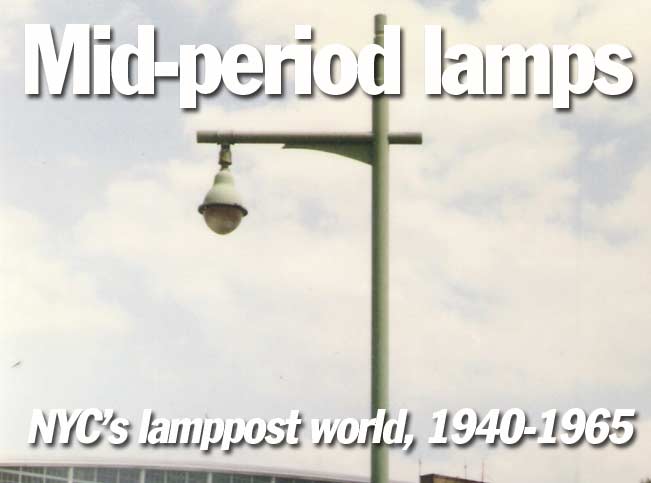In New York City, between the golden age of cast-iron lampposts, approximately 1895 and 1950, and prior to the brave new world of green-white fluorescent bulbs (which held sway between 1960 and 1972, when super-bright yellow sodium bulbs took over) there was an interregnum of sorts, when old-style yellow incandescent lights were installed on modern, streamlined, eight-sided aluminum poles. These same poles stand today, supporting the modern sodes. Here and there, though, you still find some of the old incandescents. On this page, we’ll take a look at some of them.
 There was a time, from about 1952 through 1962, when the lamppost at left was the type that dominated the streets of New York City, sharing the streets with the older, more ornate cast-iron poles.
There was a time, from about 1952 through 1962, when the lamppost at left was the type that dominated the streets of New York City, sharing the streets with the older, more ornate cast-iron poles.
The streamlined, eight-sided aluminum lamppost is topped by the cup-shaped luminaire that supported an incandescent bulb. These are the same luminaires that came to dominate the bishop-crookand long-masted cast-iron poles that dated from the 1890s and lasted, for the most part, through the 1950s.
The pole at left is in the MTA parking lot at Union Turnpike and the Van Wyck Expressway. It has since gotten a modern sodium light.
 Probably the second most common example of this type of lamppost was the one with a curved mastarm with a curved support bracket, lke the one on the right.
Probably the second most common example of this type of lamppost was the one with a curved mastarm with a curved support bracket, lke the one on the right.
These were most dominant on side streets and on main streets in secondary neighborhoods in the boroughs. In the 1960s, the DOT replaced the twin mastarms with a taller, cobra-neck shaped arm and installed green-white fluorescent bulbs, In some rare cases, though, the twin mastarms were retained.
The example at left is one of several that remain on the transverse road through Central Park at 66th Street near Fifth Avenue.
Forlornly standing in a remote section of Van Cortlandt Park east of the 242nd Street el stop is this curved mastarm lamppost. Most likely it hasn’t worked since the 1960s.
Elsewhere in Van Cortlandt Park is this mini-Whitestone-style lamp that lit a staircase. The bulb has been gone for decades.
 An unusual use of the cup-shaped luminaire, right, illuminates the pedestrian walkway that carries White Plains Road over the Amtrak/Metro-North tracks north of Tremont Avenue in the Bronx.
An unusual use of the cup-shaped luminaire, right, illuminates the pedestrian walkway that carries White Plains Road over the Amtrak/Metro-North tracks north of Tremont Avenue in the Bronx.
The city had apparently overlooked these lamps for decades, since it has relentlessly replaced most other walkway lights like these in most areas of the city. These were finally replaced by modern lights in the early 2000a.
Among the last surviving examples of Whitestone Bridge style lampposts were on the bridge that connects Long Island City to Roosevelt Island, at 36th Avenue and Vernon Boulevard.
Some of these also survived until recently on traffic ramps at LaGuardia Airport (right). To this day, traffic ramps on both the Manhattan and Brooklsyn side of the Brooklyn Bridge remain havens for this post, officially classed as Type 41 by the city when first installed on the Whitestone Bridge in the late 1930s.

Near Roosevelt Avenue, Queens, 1980
Westinghouse Whiteways near Brooklyn Bridge, 1980. The Whiteways were among the first mercury luminaires and appeared exclusively in Manhattan along Third Avenue, after the el was removed, and Ninth Avenue. These bad boys had six bulbs in each luminaire!

Double mast on West Street, 1978.Photo: Bob Mulero.
These double masts were employed on buildings where trucks were pulling into unload goods. This avoided the possibility of the trucks banging into sidewalk-mounted poles and knocking them over. Other wall lights were employed in the same manner.
A tragic casualty…

The mast above was probably the last of its kind left in New York City. at Eldert Lane and 95th Avenue on the Brooklyn-Queens border. It’s a double-mast, with a central support shaft, of a design that has pretty much survived to the present day.
But these early models had subtle differences. The shaft is extended below the mast and supports, or used to support, an orange fire alarm light, a feature these kind of masts no longer uses.
The DOT cares little for ancient lamppost designs. Its job is to light the streets to move traffic safely and adequately keep the streets lit. Fortunately I was able to shoot this fossil before the DOT did its duty!
Alas, the Department Of Transportation,in its relentless war on old lamppost designs, has recently claimed a casualty. The 1940s-era mast, at left, which was at Eldert Lane and 95th Avenue on the Brooklyn-Queens line, has been replaced in 1999 by a standard-issue finned mast (shown below.)






